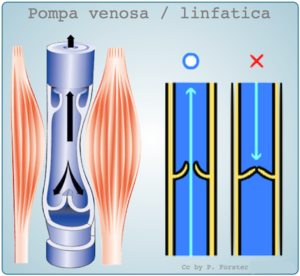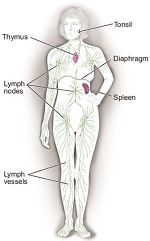Lymphatic System
Introduction:[edit | edit source]
Lymph is the fluid that flows through the lymphatic system and surrounds all tissues. It flows through lymphatic vessels and lymph nodes and is part of the immune system that is responsible for removing foreign microbes to lymph nodes and returning proteins to the blood. Unlike blood, which flows around the body in a loop by force created by the pumping mechanism of the heart, lymph flows in only one direction, upwards towards the neck. The direction of the flow of lymph is controlled by valves and the flow is controlled by force created by activation surrounding muscles and the fact that the pressure is different than in blood vessels [1]. Problems that lymph may cause are primarily because there is no pump like blood have [2].
Lymph Lymph contains lymphocytes and macrophages which are important cells;
- Lymphocytes contain T Cells, B Cells, and killer cells that increase in number to fight disease and any foreign object detected by the body.
- Microphages that absorb, or better say eat foreign microbe.
Parts of Lymphatic Tissue, Hydrodynamics and Lymphatic Transport:[edit | edit source]
The lymphatic system includes lymph nodes, spleen, lymph vessels, thymus, lymph ducts [3]. It can be described as having two types of lymph pumps: intrinsic and extrinsic. Extrinsic lymph pump are muscle, arterial and respiration. Intrisnsic lymph pump are contraction of lymphatic vessels. There are two existing types of pressures near atmospheric and negative relative pressures. The peripheral lymphatic network has lower pressure than final tracts and average lymph pressures are lesser than the venous network where lymph finally flow [4],[5].
Physiotherapy:[edit | edit source]
Physiotherapy has a crucial part in resolving problems with the lymph using the technique lymphatic drainage and exercise [6],[2], [7] [8]. Exercise induces transport of lymph. Movement of muscles and arterial pulses cause the transport of lymph through the lymphatic system. Being active therefore has a positive effect of lymphatic system and the movement of lymph through our body. Some activities that are recommended are swimming, brisk walking, tennis, jumping, gymnastic, deep breathing, etc [9] [10]
It has been proven the effect of manual lymph drainage in some cases for example:
- Hind foot operations:the application of lymph drainage techniques after hindfoot operations, in combination with standard physiotherapy exercises, achieves greater limb volume reduction than exercise alone. [11]
- Breast cancer related lymph edema:[12] [13]
- Sports Medicine and Rehabilitation.[14]
References:[edit | edit source]
- ↑ The Editors of Encyclopaedia Britannica. Lymph. Available from:https://www.britannica.com/science/lymph, (accessed 15/02/2019)
- ↑ 2.0 2.1 L.Felts. Detox your lymph: 10 holistic treatments for your lymphatic system. Available from: https://thechalkboardmag.com/detox-your-lymph-10-holistic-treatments-for-lymphatic-system (accessed 13/02/2019)
- ↑ M. MacGill. What does the lymphatic system do. Available from:https://www.medicalnewstoday.com/articles/303087.php (accessed 17/02/2019)
- ↑ Zawieja DC. Contractile physiology of lymphatics. Lymphatic research and biology. 2009; 7(2): 87-96
- ↑ Gashev A.A, Zawieja D.C. Hydrodynamic regulation of lymphatic transport and the impact of aging. Patophysiology. 2010; 17(4): 277-287
- ↑ A. Weil. Lymphatic Massage Therapy. Available from: https://www.drweil.com/health-wellness/balanced-living/wellness-therapies/lymphatic-massage-therapy/ (accessed 12/02/2019)
- ↑ Boon C.C. Manual lymph drainage. Available from: https://www.physio-pedia.com/manual_lymph_drainage (accessed 11/02/2019)
- ↑ Dіdem K, Ufuk YS, Serdar S, Zümre A. The comparison of two different physiotherapy methods in treatment of lymphedema after breast surgery. Breast cancer research and treatment. 2005 Sep 1;93(1):49-54.
- ↑ L. Vandermeeren, G. Van Damme, S. Stein, N. Devoogdt, B. Clerinks, P. Vlecken, L. Martens, K. Tollenaere, N. Beauloye. Report Patient Day 29 october 2017. Available from: https://www.belymph.org/web/en/belymph/patient-day (accessed 16/02/2019)
- ↑ S. Ding. 16 warning sings that you need to drain your lymphatic fluids. Available from: https://juicing-for-health.com/how-to-drain-your-lymphatic-fluids (accessed 12/02/2019)
- ↑ Kessler T, de Bruin E, Brunner F, Vienne P, Kissling R. Effect of manual lymph drainage after hindfoot operations. Physiotherapy Research International. 2003 Jun;8(2):101-10.
- ↑ Atalay OT, Özkir A, Çalik BB, Baskan E, Taşkin H. Effects of phase I complex decongestive physiotherapy on physical functions and depression levels in breast cancer related lymph edema. Journal of physical therapy science. 2015;27(3):865-70.
- ↑ Lacomba MT, Sánchez MJ, Goñi ÁZ, Merino DP, del Moral OM, Téllez EC, Mogollón EM. Effectiveness of early physiotherapy to prevent lymphoedema after surgery for breast cancer: randomised, single blinded, clinical trial. Bmj. 2010 Jan 13;340:b5396.
- ↑ Vairo GL, Miller SJ, Rier NC, Uckley WI. Systematic review of efficacy for manual lymphatic drainage techniques in sports medicine and rehabilitation: an evidence-based practice approach. Journal of Manual & Manipulative Therapy. 2009 Jul 1;17(3):80E-9E.








